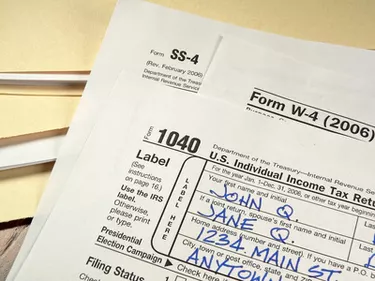
A section 1031 tax-deferred exchange is a way that real estate owners can sell investment real estate and buy a replacement piece, or pieces, of investment real estate while deferring both the capital gains tax as well as any depreciation recapture tax. Many private investors use this as a way to keep all of their equity active in real estate without ever having to pay taxes.
Selling Your Downleg Property
Video of the Day
When doing a 1031 exchange, selling the "relinquished" or "downleg" property is much like selling the property when you are not doing an exchange. The only difference is that you will need to have special language in your purchase agreement to allow you do do the exchange, and have a relationship set up with a qualified intermediary to help you with your exchange before your downleg closes.
Video of the Day
Qualified Intermediaries
To perfect a 1031 Exchange, the IRS requires that you never touch the money from the sale. Because of this requirements, a qualified intermediary needs to receive and hold the sale proceeds until they can disburse them to purchase your replacement. Frequently, your title company can serve as your QI, or you can also use an attorney. Be aware that QI's are not regulated and that they will be holding your money until it is used in a sale. As such, it is crucially important to use a QI that you trust.
Identifying Your Upleg Property
The IRS requires you to identify the property, or properties, that you will be buying within 45 days of the closing of your downleg property. Most investors use the "Three Property" rule, which allows you to designate three properties of which you can buy one, two or three of them. Other rules include the "200% Rule," which allows you to identify as many properties as you want, as long as they do not exceed twice the value of the relinquished property and the "95% Rule" which also allows you to identify as many properties as you want, as long as you buy 95 percent of them. If you do not identify properties by the deadline, the exchange fails. If you are unable to buy any of the identified properties, the exchange will also fail.
Closing on Your Upleg
You must close on your upleg property within 180 days of the closing of your downleg, or 135 days after the end of the identification period. At this time, the QI will release the money to buy the property, and you will own it. As with the downleg, you need to include special language in your purchase agreement to make it possible to do the 1031.
Benefits of a 1031 Exchange
The key benefit of a 1031 Exchange is that it allows you to reinvest all of your capital without having to pay capital gains tax. It also allows you to carry your basis and accumulated depreciation forward, saving your from paying depreciation recapture tax. The tax savings do more than just reduce your cash outlays. They also allow you to invest more money, increasing your ability to generate returns in the future. Although you will need to pay tax on the entire balance when you finally sell your real estate, if you die and pass it on to your heirs, they will benefit from the stepped up basis and be able to avoid paying any capital gains taxes at all.